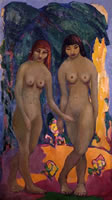
Phelan Gibb
Two Women, circa 1906

Phelan Gibb (1870 - 1948)
Painter and potter, born in Alnwick, Northumberland, his full name Henry William Gibb, son of the artist Thomas Henry Gibb and brother of Sadie Gibb. Until 1895, he showed as H W Gibb, then began using his grandmother's maiden name Phelan after the initials H W, later describing himself as Henry - or Harry - Phelan Gibb, or just Phelan Gibb. Phelan (pronounced Faylan) Gibb studied in Newcastle, Edinburgh, Paris, Antwerp and Munich. For a quarter of a century he worked in Paris and was influenced by the work of Cezanne. He exhibited in group exhibitions at Salon d'Automne, the AAA as well as Wertheim, Alpine and Redfern Galleries, RHA, RSA and in New York. Had first London solo show at Baillie Gallery, 1911. Gibb's rather earthy and apparently naive work was highly thought of by Roger Fry, Gertrude Stein and the dealer Lucy Wertheim. She supported him and his much younger second wife in their declining years with money, assistance to travel to France and even clothes but Gibb, an uneven painter, was unable to match his finest work of the period 1910-20. Gibb appears in Wertheim's memoir Adventure in Art. Between the wars the Gibbs had as one of their adresses in London and the provinces a cottage near Brendon, Devon, called Desolate, distinctively marked on the Ordonnance Survey map. Phelan painted "pot-boilers", which he donated to agricultural shows as prizes for the best sheep. He died of a heart attack in Great Hampden, Buckinghamshire. There was a posthumous solo exhibition at Alwin Gallery, 1961, but only one picture sold. Duncan Campbell Fine Art latterly handled Gibb's work. Tate Gallery and Victoria & Albert Museum hold examples.
See additional works by Phelan Gibb on www.lissllewellyn.com >
 sold
sold  reserved
reserved  private collection
private collection